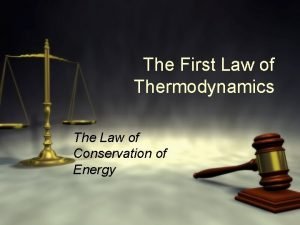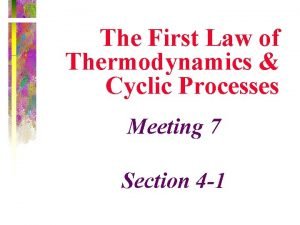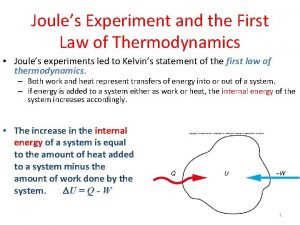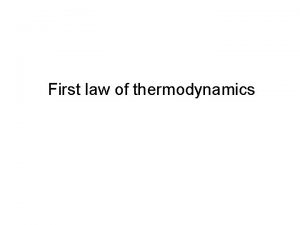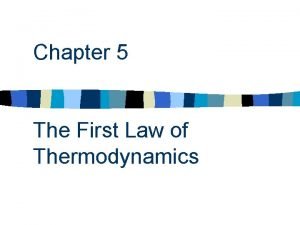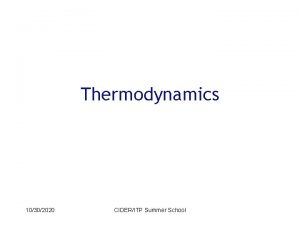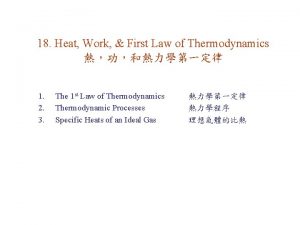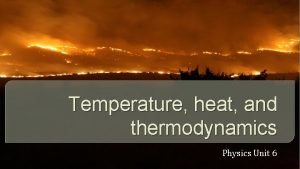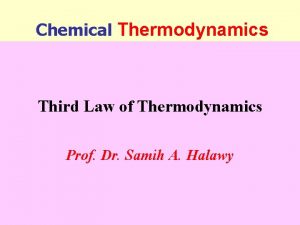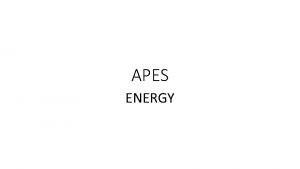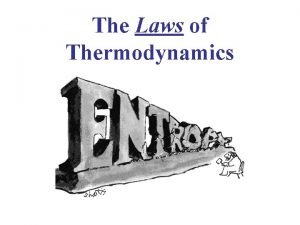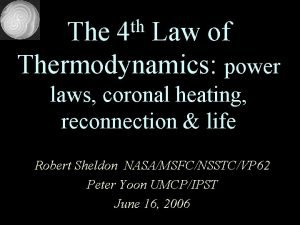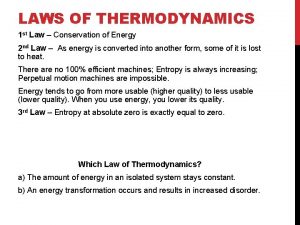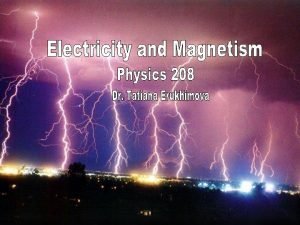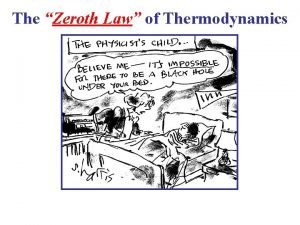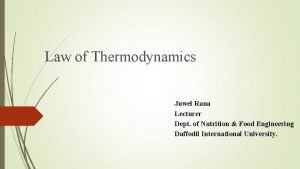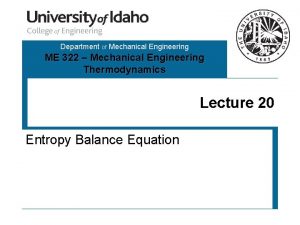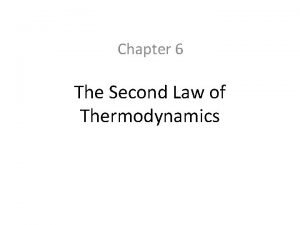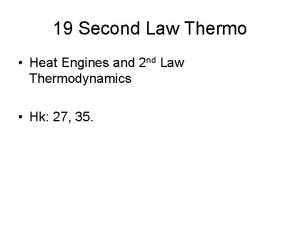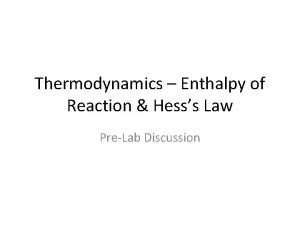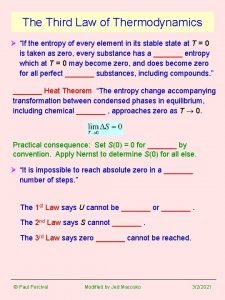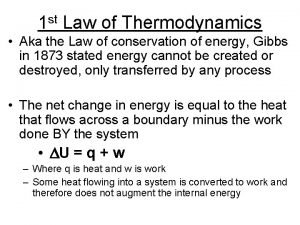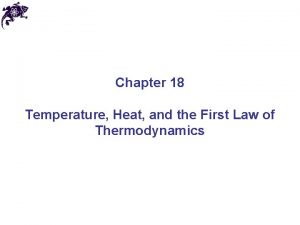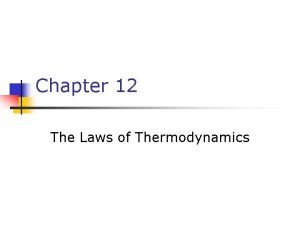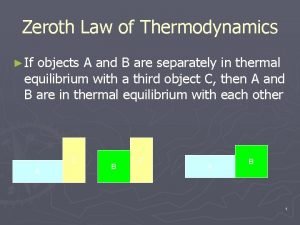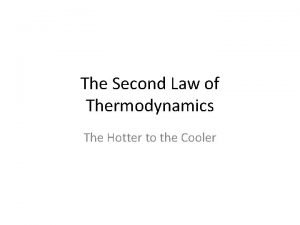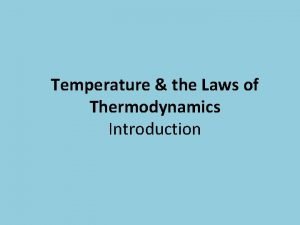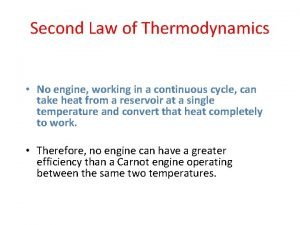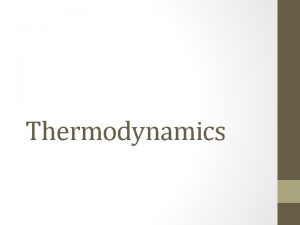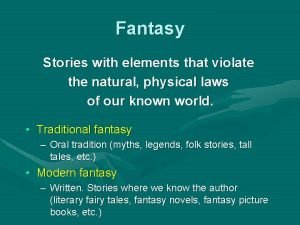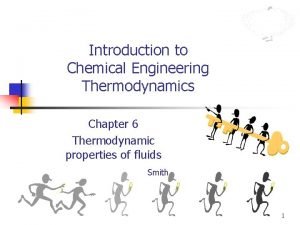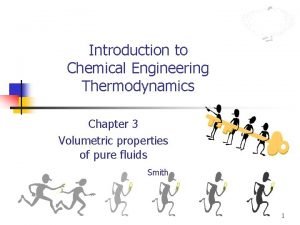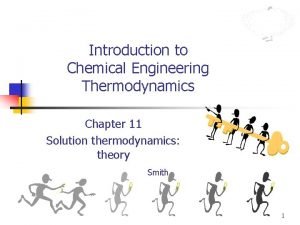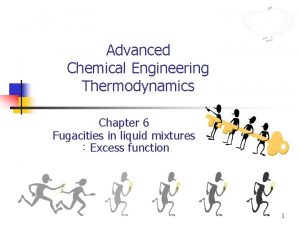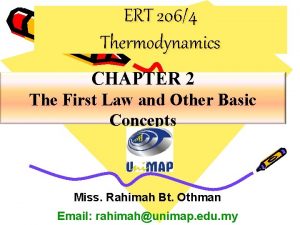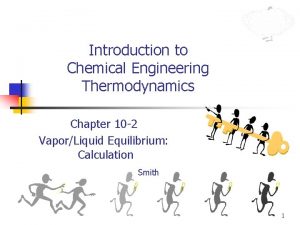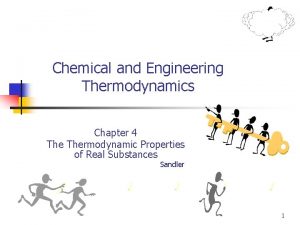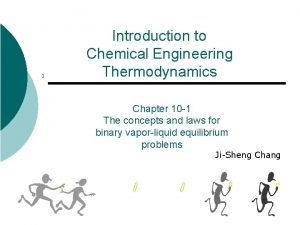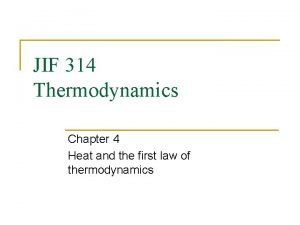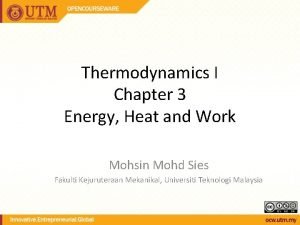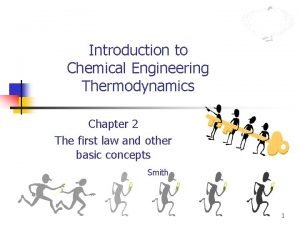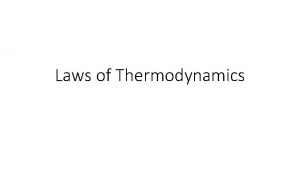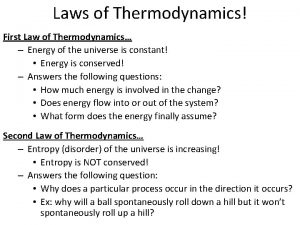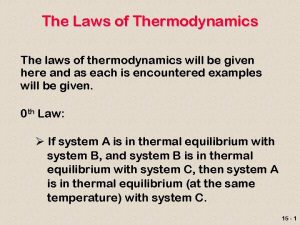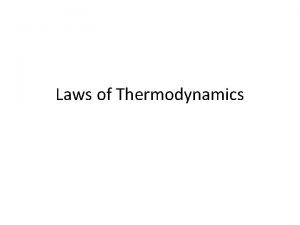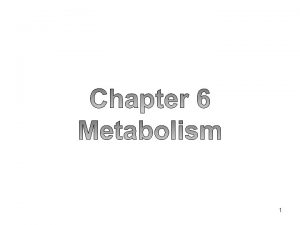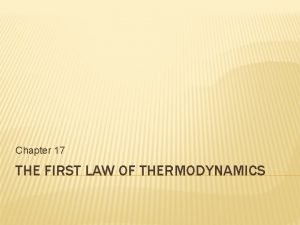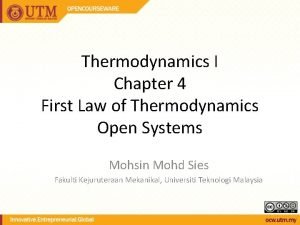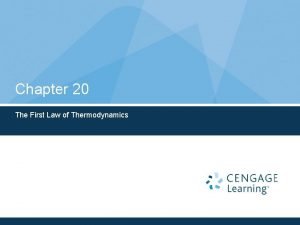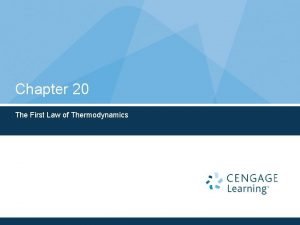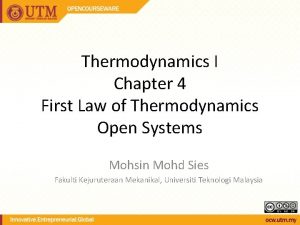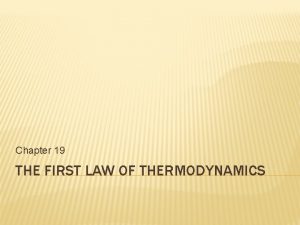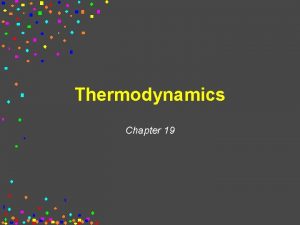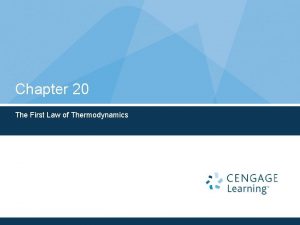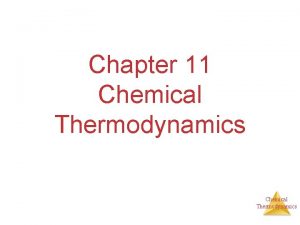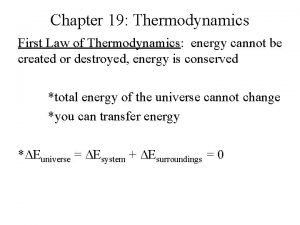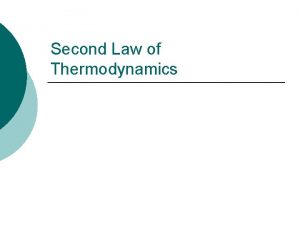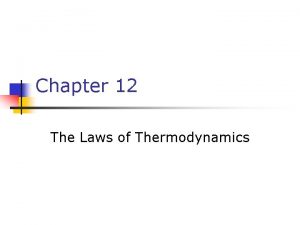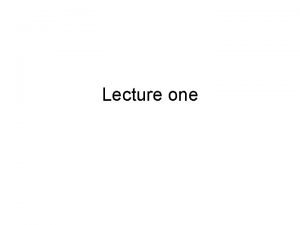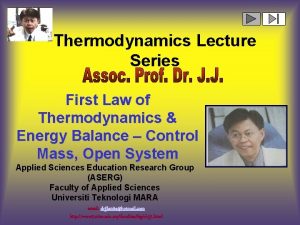Chapter 12 The Laws of Thermodynamics First Law


























































- Slides: 58

Chapter 12 The Laws of Thermodynamics

First Law of Thermodynamics n The First Law of Thermodynamics tells us that the internal energy of a system can be increased by n n n Adding energy to the system Doing work on the system There are many processes through which these could be accomplished n As long as energy is conserved

Second Law of Thermodynamics n n n Constrains the First Law Establishes which processes actually occur Heat engines are an important application

Work in Thermodynamic Processes – Assumptions n n Dealing with a gas Assumed to be in thermodynamic equilibrium n n n Every part of the gas is at the same temperature Every part of the gas is at the same pressure Ideal gas law applies

Work in a Gas Cylinder n n The gas is contained in a cylinder with a moveable piston The gas occupies a volume V and exerts pressure P on the walls of the cylinder and on the piston

Work in a Gas Cylinder, cont. n A force is applied to slowly compress the gas n n The compression is slow enough for all the system to remain essentially in thermal equilibrium W = - P ∆V n This is the work done on the gas

More about Work on a Gas Cylinder n When the gas is compressed n n n When the gas is allowed to expand n n n ∆V is negative The work done on the gas is positive ∆V is positive The work done on the gas is negative When the volume remains constant n No work is done on the gas

Notes about the Work Equation n The pressure remains constant during the expansion or compression n n This is called an isobaric process If the pressure changes, the average pressure may be used to estimate the work done

PV Diagrams n n Used when the pressure and volume are known at each step of the process The work done on a gas that takes it from some initial state to some final state is the negative of the area under the curve on the PV diagram n This is true whether or not the pressure stays constant

PV Diagrams, cont. n n The curve on the diagram is called the path taken between the initial and final states The work done depends on the particular path n Same initial and final states, but different amounts of work are done

First Law of Thermodynamics n n Energy conservation law Relates changes in internal energy to energy transfers due to heat and work Applicable to all types of processes Provides a connection between microscopic and macroscopic worlds

First Law, cont. n Energy transfers occur due to n By doing work n n By heat n n Requires a macroscopic displacement of an object through the application of a force Occurs through the random molecular collisions Both result in a change in the internal energy, DU, of the system

First Law, Equation n If a system undergoes a change from an initial state to a final state, then DU = Uf – Ui = Q + W n n n Q is the energy transferred to the system by heat W is the work done on the system DU is the change in internal energy

First Law – Signs n Signs of the terms in the equation n Q n n n W n n n Positive if energy is transferred to the system by heat Negative if energy is transferred out of the system by heat Positive if work is done on the system Negative if work is done by the system DU n n Positive if the temperature increases Negative if the temperature decreases

Results of DU n Changes in the internal energy result in changes in the measurable macroscopic variables of the system n These include n n n Pressure Temperature Volume

Notes About Work n n n Positive work increases the internal energy of the system Negative work decreases the internal energy of the system This is consistent with the definition of mechanical work

Molar Specific Heat n The molar specific heat at constant volume for an ideal gas n n Cv = 3/2 R The change in internal energy can be expressed as DU = n Cv DT n For an ideal gas, this expression is always valid, even if not at a constant volume

Molar Specific Heat, cont n n n A gas with a large molar specific heat requires more energy for a given temperature change The value depends on the structure of the gas molecule The value also depends on the ways the molecule can store energy

Degrees of Freedom n n n Each way a gas can store energy is called a degree of freedom Each degree of freedom contributes 1/2 R to the molar specific heat See table 12. 1 for some Cvvalues

Types of Thermal Processes n Isobaric n n n Isovolumetric n n n Volume stays constant Vertical line on the PV diagram Isothermal n n Pressure stays constant Horizontal line on the PV diagram Temperature stays the same Adiabatic n No heat is exchanged with the surroundings

Isolated System n n n An isolated system does not interact with its surroundings No energy transfer takes place and no work is done Therefore, the internal energy of the isolated system remains constant

Cyclic Processes n A cyclic process is one in which the process originates and ends at the same state n n Uf = Ui and Q = -W The net work done per cycle by the gas is equal to the area enclosed by the path representing the process on a PV diagram

Heat Engine n n A heat engine takes in energy by heat and partially converts it to other forms In general, a heat engine carries some working substance through a cyclic process

Heat Engine, cont. n n n Energy is transferred from a source at a high temperature (Qh) Work is done by the engine (Weng) Energy is expelled to a source at a lower temperature (Qc)

Heat Engine, cont. n Since it is a cyclical process, ∆U = 0 n n Its initial and final internal energies are the same Therefore, Qnet = Weng The work done by the engine equals the net energy absorbed by the engine The work is equal to the area enclosed by the curve of the PV diagram

Thermal Efficiency of a Heat Engine n n Thermal efficiency is defined as the ratio of the work done by the engine to the energy absorbed at the higher temperature e = 1 (100% efficiency) only if Qc = 0 n No energy expelled to cold reservoir

Heat Pumps and Refrigerators n Heat engines can run in reverse n n Energy is injected Energy is extracted from the cold reservoir Energy is transferred to the hot reservoir This process means the heat engine is running as a heat pump n n A refrigerator is a common type of heat pump An air conditioner is another example of a heat pump

Heat Pump, cont n n n The work is what you pay for The Qc is the desired benefit The coefficient of performance (COP) measures the performance of the heat pump running in cooling mode

Heat Pump, COP n n n In cooling mode, The higher the number, the better A good refrigerator or air conditioner typically has a COP of 5 or 6

Heat Pump, COP n n n In heating mode, The heat pump warms the inside of the house by extracting heat from the colder outside air Typical values are greater than one

Second Law of Thermodynamics n No heat engine operating in a cycle can absorb energy from a reservoir and use it entirely for the performance of an equal amount of work n n Kelvin – Planck statement Means that Qc cannot equal 0 n n Some Qc must be expelled to the environment Means that e must be less than 100%

Summary of the First and Second Laws n First Law n n We cannot get a greater amount of energy out of a cyclic process than we put in Second Law n We can’t break even

Reversible and Irreversible Processes n A reversible process is one in which every state along some path is an equilibrium state n n An irreversible process does not meet these requirements n n And one for which the system can be returned to its initial state along the same path Most natural processes are irreversible Reversible process are an idealization, but some real processes are good approximations

Sadi Carnot n n 1796 – 1832 French Engineer Founder of the science of thermodynamics First to recognize the relationship between work and heat

Carnot Engine n n n A theoretical engine developed by Sadi Carnot A heat engine operating in an ideal, reversible cycle (now called a Carnot Cycle) between two reservoirs is the most efficient engine possible Carnot’s Theorem: No real engine operating between two energy reservoirs can be more efficient than a Carnot engine operating between the same two reservoirs

Carnot Cycle

Carnot Cycle, A to B n n A to B is an isothermal expansion at temperature Th The gas is placed in contact with the high temperature reservoir The gas absorbs heat Qh The gas does work WAB in raising the piston

Carnot Cycle, B to C n n n B to C is an adiabatic expansion The base of the cylinder is replaced by a thermally nonconducting wall No heat enters or leaves the system The temperature falls from Th to Tc The gas does work WBC

Carnot Cycle, C to D n n The gas is placed in contact with the cold temperature reservoir at temperature Tc C to D is an isothermal compression The gas expels energy QC Work WCD is done on the gas

Carnot Cycle, D to A n n D to A is an adiabatic compression The gas is again placed against a thermally nonconducting wall n n n So no heat is exchanged with the surroundings The temperature of the gas increases from TC to Th The work done on the gas is WCD

Carnot Cycle, PV Diagram n n The work done by the engine is shown by the area enclosed by the curve The net work is equal to Qh - Qc

Efficiency of a Carnot Engine n n n Carnot showed that the efficiency of the engine depends on the temperatures of the reservoirs Temperatures must be in Kelvins All Carnot engines operating between the same two temperatures will have the same efficiency

Notes About Carnot Efficiency n n Efficiency is 0 if Th = Tc Efficiency is 100% only if Tc = 0 K n n n Such reservoirs are not available The efficiency increases as Tc is lowered and as Th is raised In most practical cases, Tc is near room temperature, 300 K n So generally Th is raised to increase efficiency

Real Engines Compared to Carnot Engines n All real engines are less efficient than the Carnot engine n n Real engines are irreversible because of friction Real engines are irreversible because they complete cycles in short amounts of time

Entropy n n A state variable related to the Second Law of Thermodynamics, the entropy Let Qr be the energy absorbed or expelled during a reversible, constant temperature process between two equilibrium states. Then the change in entropy during any constant temperature process connecting the two equilibrium states can be defined as the ratio of the energy to the temperature

Entropy, cont. n n Mathematically, This applies only to the reversible path, even if the system actually follows an irreversible path n n n To calculate the entropy for an irreversible process, model it as a reversible process When energy is absorbed, Q is positive and entropy increases When energy is expelled, Q is negative and entropy decreases

More About Entropy n n Note, the equation defines the change in entropy The entropy of the Universe increases in all natural processes n n This is another way of expressing the Second Law of Thermodynamics There are processes in which the entropy of a system decreases n n If the entropy of one system, A, decreases it will be accompanied by the increase of entropy of another system, B. The change in entropy in system B will be greater than that of system A.

Perpetual Motion Machines n n A perpetual motion machine would operate continuously without input of energy and without any net increase in entropy Perpetual motion machines of the first type would violate the First Law, giving out more energy than was put into the machine Perpetual motion machines of the second type would violate the Second Law, possibly by no exhaust Perpetual motion machines will never be invented

Entropy and Disorder n n Entropy can be described in terms of disorder A disorderly arrangement is much more probable than an orderly one if the laws of nature allowed to act without interference n This comes from a statistical mechanics development

Entropy and Disorder, cont. n Isolated systems tend toward greater disorder, and entropy is a measure of that disorder n S = k. B ln W n n k. B is Boltzmann’s constant W is a number proportional to the probability that the system has a particular configuration This gives the Second Law as a statement of what is most probable rather than what must be The Second Law also defines the direction of time of all events as the direction in which the entropy of the universe increases

Grades of Energy n n n The tendency of nature to move toward a state of disorder affects a system’s ability to do work Various forms of energy can be converted into internal energy, but the reverse transformation is never complete If two kinds of energy, A and B, can be completely interconverted, they are of the same grade

Grades of Energy, cont. n n If form A can be completely converted to form B, but the reverse is never complete, A is a higher grade of energy than B When a high-grade energy is converted to internal energy, it can never be fully recovered as high-grade energy Degradation of energy is the conversion of high-grade energy to internal energy In all real processes, the energy available for doing work decreases

Heat Death of the Universe n n The entropy of the Universe always increases The entropy of the Universe should ultimately reach a maximum n n n At this time, the Universe will be at a state of uniform temperature and density This state of perfect disorder implies no energy will be available for doing work This state is called the heat death of the Universe

The First Law and Human Metabolism n n n The First Law can be applied to living organisms The internal energy stored in humans goes into other forms needed by the organs and into work and heat The metabolic rate (∆U / ∆T) is directly proportional to the rate of oxygen consumption by volume

Measuring Metabolic Rate n n The metabolic rate is related to oxygen consumption by About 80 W is the basal metabolic rate, just to maintain and run different body organs

Various Metabolic Rates

Aerobic Fitness n One way to measure a person’s physical fitness is their maximum capacity to use or consume oxygen

Efficiency of the Human Body n Efficiency is the ratio of the mechanical power supplied to the metabolic rate or total power input
 First law of thermodynamics in open system
First law of thermodynamics in open system First law of thermodynamics
First law of thermodynamics First law of thermodynamics for cyclic process
First law of thermodynamics for cyclic process First law of thermodynamics experiment
First law of thermodynamics experiment Isothermal process in thermodynamics
Isothermal process in thermodynamics Steady flow process thermodynamics
Steady flow process thermodynamics First law of thermodynamics sign convention
First law of thermodynamics sign convention First law of thermodynamics control mass
First law of thermodynamics control mass Gibbs free energy
Gibbs free energy Thermodynamics of ideal gases
Thermodynamics of ideal gases Newton's first law and second law and third law
Newton's first law and second law and third law Newton's first law of motion
Newton's first law of motion Laws of thermodynamics simple
Laws of thermodynamics simple Thermodynamics rules
Thermodynamics rules Repleneshed
Repleneshed Laws thermodynamics
Laws thermodynamics Zeroth law of thermodynamics examples
Zeroth law of thermodynamics examples Thermodynamics laws
Thermodynamics laws Laws of thermo dynamics
Laws of thermo dynamics Facts about montesquieu
Facts about montesquieu Dr erukhimova
Dr erukhimova Zeroth law of thermodynamics definition
Zeroth law of thermodynamics definition Newtons third law of thermodynamics
Newtons third law of thermodynamics Second law of thermodynamics
Second law of thermodynamics Zeroth law of thermodynamics
Zeroth law of thermodynamics What is second law of thermodynamics
What is second law of thermodynamics Second law of thermodynamics
Second law of thermodynamics 2nd law of thermodynamics
2nd law of thermodynamics Thermodynamics enthalpy of reaction and hess's law
Thermodynamics enthalpy of reaction and hess's law Third law of thermodynamics is depend on
Third law of thermodynamics is depend on 1st law of thermodynamics
1st law of thermodynamics 1st law of thermodynamics
1st law of thermodynamics 1st law of thermodynamics
1st law of thermodynamics Zeroth law of thermodynamics
Zeroth law of thermodynamics Second law of thermodynamics
Second law of thermodynamics Zeroth law of thermodynamics
Zeroth law of thermodynamics Define second law of thermodynamics
Define second law of thermodynamics Frist law of thermodynamics
Frist law of thermodynamics Boyle's law charles law avogadro's law
Boyle's law charles law avogadro's law How to calculate boyle's law
How to calculate boyle's law How does newton's law of gravity extend kepler's laws
How does newton's law of gravity extend kepler's laws 3 laws in law of inheritance
3 laws in law of inheritance Law 32 48 laws of power
Law 32 48 laws of power Chemical engineering thermodynamics 8th solution chapter 6
Chemical engineering thermodynamics 8th solution chapter 6 Chemical engineering thermodynamics 8th solution chapter 3
Chemical engineering thermodynamics 8th solution chapter 3 Chemical engineering thermodynamics 8th solution chapter 4
Chemical engineering thermodynamics 8th solution chapter 4 Chapter 6
Chapter 6 Which of the following system is a control mass system
Which of the following system is a control mass system Chemical engineering thermodynamics 8th solution chapter 10
Chemical engineering thermodynamics 8th solution chapter 10 Thermodynamics chapter 4
Thermodynamics chapter 4 Thermodynamics for chemical engineering
Thermodynamics for chemical engineering Dq=cpdt-vdp
Dq=cpdt-vdp Thermodynamics chapter 3
Thermodynamics chapter 3 Introduction to chemical engineering thermodynamics
Introduction to chemical engineering thermodynamics Hình ảnh bộ gõ cơ thể búng tay
Hình ảnh bộ gõ cơ thể búng tay Bổ thể
Bổ thể Tỉ lệ cơ thể trẻ em
Tỉ lệ cơ thể trẻ em Gấu đi như thế nào
Gấu đi như thế nào

